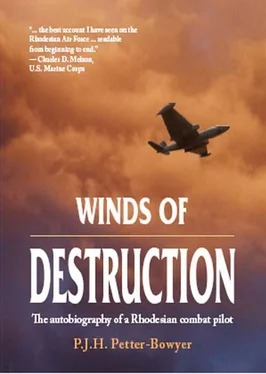Peter Petter-Bowyer - Winds of Destruction
Здесь есть возможность читать онлайн «Peter Petter-Bowyer - Winds of Destruction» весь текст электронной книги совершенно бесплатно (целиком полную версию без сокращений). В некоторых случаях можно слушать аудио, скачать через торрент в формате fb2 и присутствует краткое содержание. Город: Solihull, Pinetown, Год выпуска: 2012, ISBN: 2012, Издательство: Helion & Company, 30° South Publishers, Жанр: Биографии и Мемуары, на английском языке. Описание произведения, (предисловие) а так же отзывы посетителей доступны на портале библиотеки ЛибКат.
- Название:Winds of Destruction
- Автор:
- Издательство:Helion & Company, 30° South Publishers
- Жанр:
- Год:2012
- Город:Solihull, Pinetown
- ISBN:9781908916754
- Рейтинг книги:5 / 5. Голосов: 1
-
Избранное:Добавить в избранное
- Отзывы:
-
Ваша оценка:
- 100
- 1
- 2
- 3
- 4
- 5
Winds of Destruction: краткое содержание, описание и аннотация
Предлагаем к чтению аннотацию, описание, краткое содержание или предисловие (зависит от того, что написал сам автор книги «Winds of Destruction»). Если вы не нашли необходимую информацию о книге — напишите в комментариях, мы постараемся отыскать её.
Winds of Destruction — читать онлайн бесплатно полную книгу (весь текст) целиком
Ниже представлен текст книги, разбитый по страницам. Система сохранения места последней прочитанной страницы, позволяет с удобством читать онлайн бесплатно книгу «Winds of Destruction», без необходимости каждый раз заново искать на чём Вы остановились. Поставьте закладку, и сможете в любой момент перейти на страницу, на которой закончили чтение.
Интервал:
Закладка:
The hijacking of a twenty-ton truck driven by its white owner was successful but became complicated when the brother of the driver, noticing that the twenty-tonner was no longer following his own truck, turned back to investigate. This man refused to leave his brother.
In the meanwhile, a third white man stopped, believing the twenty-ton truck had broken down. As if this was not bad enough, a ten-year-old white boy was accompanying one of the brothers, his uncle, as a special birthday treat. Consequently, for security reasons, the SAS had to hold captive the three white men, two black co-drivers and the ten-year-old birthday boy. Once the charges were set and fuses lit, the twenty-ton truck carrying twenty-two people with canoes and dinghy set off down the main road towards Lusaka. Some way from the bridges the satisfying sound of a single huge explosion reached the men; but they had no way of knowing if the bridges were down. When dawn was breaking a little short of the small town of Serenje, the truck turned south down a secondary road towards the Luangwa Game Reserve.
Unhappily they came upon a power station in the middle of nowhere and the SAS were forced to shoot security guards who came to investigate their presence. From there they managed to bundu-bash their way to a position where the Cheetahs collected them, captives and all. By this time the SAS team was relieved to get the news via their HF radio that Canberra reconnaissance had confirmed both bridges were down.
The hapless Zambians were noticeably apprehensive about their own safety right up to the moment they were ushered into the Cheetahs. Thereafter they relaxed and were treated to Rhodesian hospitality until suitable arrangements were made for their safe return to Zambia.

Moatize bridges

THE OP MANACLE PLAN TO destroy all Mozambique’s bridges was initiated with the downing of three rail bridges on the line north of the Zambezi River. Apart from denying ZANLA any rail transport for men and munitions from Beira to Tete Province, severing the line at this particular time complemented the cutting of the Tanzam rail at the Chambeshi River. With this rail line also cut, Zambia would have no Mozambican outlet as an alternative to the South African ports.
Ten months had passed since the SAS destroyed the Mecito bridge and the train that was crossing it. No attempt had been made to repair the bridge or recover the engine that remained nose down in the riverbed, but trains were being run to each side of the river to transfer passengers and porter goods from one train to another. The destruction of another three widely separated bridges would put an end to this practice.
Dakotas delivered three SAS teams to the bridges during the evening of 12 October 1979. Early next morning, Cheetahs brought in the heavy explosive packs and the three bridges were dropped in daylight on the same day.
FRELIMO guards at the biggest bridge had fled when their fire was answered with overwhelming aggression. Apart from this, no opposition occurred save from a swarm of bees. Stirred to anger by detonation pressure waves, thousands of bees attacked all the members of one team, causing two to be hospitalised. Also stirred to anger was the FRELIMO Government.
Improved methods of packaging and laying demolition charges had worked so well for the SAS on the five bridges in Mozambique and Zambia that the same principles were adopted and tailored for each of the bridges assigned for destruction during Op Manacle. When all was ready however, the Mozambican op was postponed at short notice. The SAS were about to launch from Chipinda Pools in southeast Rhodesia when analysis of intelligence confirmed the imminence of a ZIPRA invasion. Understandably the SAS Regiment was incensed by the eleventh hour deferral of an operation for which they were so well prepared. It had happened many times before but, in this case, there was a general belief amongst the SAS officers that there were sinister reasons for calling off their biggest job which, for the first time ever, involved every available member of the SAS.

Encounter with conventional ZIPRA forces

FOR SOME TIME SELOUS SCOUTS teams had been operating inside Zambia on recce and disruption tasks south of the main road from Lusaka to Livingstone. Helicopters were used for all deployments and recoveries and a limited amount of assistance was given to Scouts by Lynx pilots making visual recce sorties to assist in the selection of unpopulated routes.
First indications of a ZIPRA conventional force in the remote dry country northwest of Kariba came from one Lynx pilot who reported encountering heavy anti-aircraft gunfire when he was returning to base from a recce task. Little notice was taken of this until two helicopter pilots were subjected to the same treatment from precisely the same location.
The Canberra tasked to photograph the spot did so at midday on 10 October when the sun was directly above the aircraft. The Kariba area had remained completely dry in spite of heavy rains in the eastern areas of the country. In consequence, the dry white soil of the region reflected the sun’s rays so strongly that images on the photographs blended all features in a manner that made distinguishing between rocks, scrub and open ground difficult—even through stereoscopic viewers.
Apart from a single vehicle track leading to the area, the JSPIS photo-interpreters could find little of interest on or near the prominent ridge the pilots reported as being the source of enemy fire. So one of the pilots was called in to view the photographs to clarify what he had seen coming from where.
Bill Buckle was considering re-tasking a Canberra recce for 10:00 the next day to overcome the glare problem by bringing shadows into play. Whilst he pondered this with others, Norah Seear was taking another close look at the southern end of the ridge where the pilot said at least two of the guns were positioned. Vaguely, very vaguely, Norah saw lines that might be trenches—but she could not be sure.
In COMOPS we knew that the pilot reports were accurate and that ZIPRA had certainly been where the anti-aircraft fire had come from. It was decided therefore to send in the SAS to investigate rather than run another photographic sortie, which might cause ZIPRA to move away.
Captain Bob MacKenzie moved to Kariba and, on 18 October, launched two SAS patrols by helicopter. One patrol landed well to the north of the ridge to ambush the track and the second team was put down well to the south of the ridge. Once they were down, Hunters and Canberras put in strikes. As the jets cleared, a high-flying Dakota ran parallel legs each side of the ridge, dropping incendiaries in a failed attempt to burn vegetation and deny the enemy bush cover. Orbiting high over the ridge in a Lynx piloted by Air Lieutenant Trevor Jew, Bob MacKenzie took a good look at his area of operations.
Apart from the main north/south ridge-line, a lesser ridge ran parallel to it two kilometres to the west with a bone-dry water pan surrounded by thick bush occupying much of the space between them. The vehicle track from the north passed the pan on its eastern side. Bob came to the conclusion that the main base, if occupied, was on the low ground around the dry pan with primary defences high on the ridges.
Читать дальшеИнтервал:
Закладка:
Похожие книги на «Winds of Destruction»
Представляем Вашему вниманию похожие книги на «Winds of Destruction» списком для выбора. Мы отобрали схожую по названию и смыслу литературу в надежде предоставить читателям больше вариантов отыскать новые, интересные, ещё непрочитанные произведения.
Обсуждение, отзывы о книге «Winds of Destruction» и просто собственные мнения читателей. Оставьте ваши комментарии, напишите, что Вы думаете о произведении, его смысле или главных героях. Укажите что конкретно понравилось, а что нет, и почему Вы так считаете.












